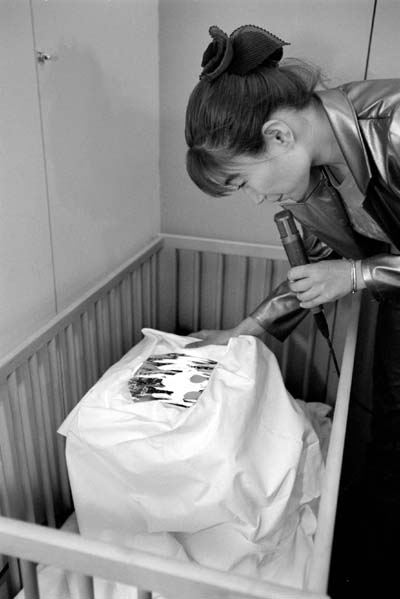Untitled Document
Computer Baby Popular All Over the World
Close emotional interaction with a computer? Are you kidding?
The most people feel for a computer is usually 'computer rage',
in the worst case this may result in beating the computer up.
Not Japanese artist and computer scientist Dr. Naoko Tosa, who
wants to initiate "warm communication" with her screen
and provide "emotional feedback" from computers.

This Monday, Tosa set up a cosy baby room for her twin 'Neuro
Babies' in the main building. Neuro Baby reacts to voice intonation
and will cry if you shout, gurgle if you're nice or show surprise
at your comments. Shy students can use a squeaky toy to elicit
a reaction. "An artwork should have power. That includes
new and positive feelings. It is my artistic power to be able
to create that," says Tosa, who is affiliated with Advanced
Telecommunications Research Institute International in Japan and
MIT in the USA.
Neuro Baby is part of 'Art in Output', an interactive art exhibition
from November 2 to 23 at TU/e. Seven internationally renowned
artists are busy constructing their exhibits in the main building
this week. Every visitor will essentially create a different set
of art works, because the exhibits react to his or her behaviour.
Lying to Baby
"People's behaviour with Neuro Baby is very interesting,"
says Naoko Tosa. "Sometimes people try to lie to Neuro Baby
by saying bad things in a sweet tone of voice. Of course Neuro
Baby believes them."
The intricate programming needed for Neuro Baby has developed
since its inception in 1993, and is still improving. Tosa hopes
to contribute to better communication with computers in the future.
Neuro Baby is a neural network that can be taught to adapt. At
Tosa's Internet site Neuro Baby's expression and verbal reactions
can be influenced consecutively by people in different countries.
"I started with a big computer. Now I use two desktops and
one laptop. Next year Neuro Baby will graduate to just one laptop.
If technology grows, the baby grows," says Tosa, who is sometimes
also called 'Neuro Mama'.
Universal Theme
Would it be interesting to program Neuro Baby to grow up? "Well,
it could be. But people love this, they don't want him to grow
up. Neuro Baby taps into a universal theme and causes strong identification.
He's actually very popular with audiences the world over."
Neuro Baby understands and reacts to male and female voices saying
fifty Japanese and ten English phrases. Naoka Tosa has promised
students at TU/e she will work with them to create a Dutch version
of Neuro Baby.
Naoko Tosa attended a traditional art school in Japan, before
continuing her studies to become a computer scientist. "I'm
interested in new kinds of art and I wanted a warmer interaction
with artworks. Before Neuro Baby I did some video art, which is
akin to experimental film. But that draws only a small public,
and I want everyone to understand my work."
Other artists participating in 'Art in Output' are Holger Förterer
(Germany), David and Ulrike Gabriel (Germany), Nigel Johnson (Great
Britain), Geert Mul (Netherlands) and, Miroslaw Rogala (USA)./.
The English page in Cursor is written bij Paula van de Riet. She
can be reached at extension 4441. Email: www.engcur@stud.tue.nl





